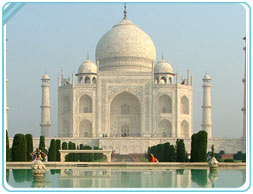 On
the bank of River Yamsua, the third Mughal Emperor Shah Jahan
immortalized his love for his beloved queen Mumtaj Mahal by constructing
this marble wonder as a tribute to her, when she died during the birth
of their fourteenth child. There is a controversy on the name of the
chief architect of Taj but there are many sources, which propose the
name of the Indian architect of Persian origin known as Ustad Ahmad
Lahori for the credit. Its construction began in 1630 and master
builders, architects, skilled masons and sculptors were imported from
all over the world including Persia and Europe to contribute to the
beauty of Taj. Twelve years of hard labor of about 20,000 laborers and
millions of rupees went into its making.
On
the bank of River Yamsua, the third Mughal Emperor Shah Jahan
immortalized his love for his beloved queen Mumtaj Mahal by constructing
this marble wonder as a tribute to her, when she died during the birth
of their fourteenth child. There is a controversy on the name of the
chief architect of Taj but there are many sources, which propose the
name of the Indian architect of Persian origin known as Ustad Ahmad
Lahori for the credit. Its construction began in 1630 and master
builders, architects, skilled masons and sculptors were imported from
all over the world including Persia and Europe to contribute to the
beauty of Taj. Twelve years of hard labor of about 20,000 laborers and
millions of rupees went into its making. There are five main elements of the Taj complex - the main gateway or 'Darwazah', the garden with its ingenious waterways or 'Bageecha', the mosque or 'Maszid', the rest house or 'Naqqar Khana' and the main tomb building or 'Rauza'. The actual graves are kept inside while the cenotaphs are placed just above them to be viewed by the general public. The beautiful marble inlay work known as 'Pietra Dura' and the well-planned gardens of Taj with their water channels and lotus pools are some of the most impressive things to see here.